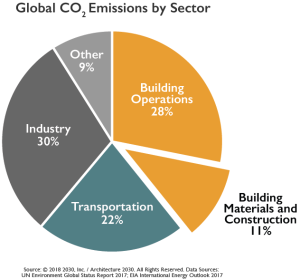Degenkolb Makes the SE 2050 Commitment

A month ago, we announced that Degenkolb Engineers had signed on to the SE 2050 Commitment Program. Today, we are excited to share more about what this means for our firm, our industry, and beyond. The program’s vision: All structural engineers shall understand, reduce, and ultimately eliminate embodied carbon in their projects by 2050. With more than 200 people across six offices along the West Coast, all of us at Degenkolb are committed to eliminating embodied carbon in structures by 2050.
What does this all exactly mean? What is embodied carbon and why is eliminating it important? And why 2050? We invite you to read on to find out.

For more information on the SE 2050 Commitment Program, please visit se2050.org.
Embodied Carbon and Climate Change
Embodied carbon is all CO2 (carbon dioxide) emitted in raw material extraction, transportation, manufacturing, construction, and end-of-life phases of buildings and infrastructure. For example, one cubic yard of concrete in a building requires approximately 400 kg CO2e of embodied carbon, which is comparable to tailpipe emissions from driving the average passenger vehicle nearly 1000 miles. Embodied carbon is distinct from operational carbon, which is all CO2 emissions involved in the operation of buildings, such as for heating, cooling, and lighting. It is now widely known that CO2 and other greenhouse gases contribute to global climate change. Embodied carbon is emitted upfront whereas operational carbon is emitted over the life of a building, meaning that reducing embodied carbon can have an immediately positive climate impact.
Why 2050?
Net zero emissions—as they are also described—means that we have reached a state in which we are not adding any new emissions to the atmosphere. Reaching this milestone by 2050 aligns with the vision of the United Nations’ Paris Agreement to keep the global temperature to 1.5 degrees Celsius above pre-industrial levels. To reach net zero, many countries and industries have been tasked with discovering and implementing ways to cut back and—ultimately—eliminate their carbon output.
Structural Engineering’s Role
Structural engineers saw the unique role they played in reaching this goal and pushing the industry forward, and thus the SE 2050 Commitment was formed. Each year, embodied carbon in buildings is responsible for 11-percent of global greenhouse gas (GHG) emissions and 28-percent of global building sector emissions. With nearly 6.13 billion square meters of new buildings popping up annually, embodied carbon will be responsible for almost half of total new construction emissions between now and 2050. Structural engineers are perfectly positioned to address the embodied carbon issue because a building’s embodied carbon and a significant portion of global emissions hinge on structural materials.
Why Degenkolb?
Degenkolb CEO Stacy Bartoletti notes that Degenkolb’s core ideology revolves around the idea that we exist to engineer the future for our clients and communities through our core values of service and expertise. “Degenkolb seeks to understand our clients’ and communities’ needs and adapt to changing conditions. We believe that doing our part to curb climate change by reducing embodied carbon on our projects and industry-wide will help meet those needs and enable us to better serve our clients and communities for years to come. We believe it is the right thing to do.”
Degenkolb also recognizes that there is much to learn and many innovations to make related to embodied carbon reduction, which made joining this commitment as a firm a straightforward choice. “We are excited to grow our expertise and help make this industry-level change, just as we have participated in code development to improve earthquake engineering practice for decades,” adds Stacy.
Looking to the Future
The SE 2050 Commitment Program is just that: a commitment over the course of decades to reach carbon neutrality. No one knows this better than Degenkolb’s very own Elena Good, a Design Engineer in our Oakland office and the firm’s designated Embodied Carbon Reduction Champion. With her deep involvement in sustainability-related causes, including the Structural Engineers Association of Northern California’s (SEAONC) Sustainability Design Committee and co-lead of Degenkolb’s Sustainability Committee, she is no stranger to these subjects. She recalls attending the Carbon Positive 2020 Conference where she was first exposed to the idea of 2050 as a goal. “I realized that by 2050, that would be the bulk of my career. It put into perspective just how big of a deal this would be for my entire career: How will this change how I engineer? How will the industry adapt to such a huge challenge?”

Elena Good, Degenkolb Oakland Design Engineer and Embodied Carbon Reduction Champion
Although there are many steps ahead before we can check off the box next to “net zero,” Degenkolb is excited to be a part of this pioneering effort. We are currently working on our Embodied Carbon Action Plan, which includes planning out how to address internal education, data reporting, embodied carbon reduction, and advocacy along with developing our capabilities to measure embodied carbon in our designs. For more information on ECAP, please visit this resource by SE 2050. We look forward to collaborating with our fellow SE 2050 Commitment Program partners towards a brighter, carbon-neutral future.
